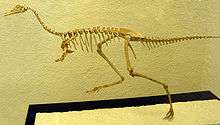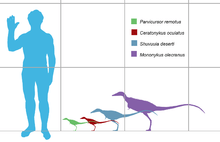Mononykus
Mononykus (/məˈnɒnɪkəs/ mə-NON-i-kəs, sometimes /ˌmɒnoʊˈnaɪkəs/ MON-oh-NY-kəs; meaning "one claw") was a theropod dinosaur from late Cretaceous Mongolia (Nemegt Formation, about 70 million years ago) with long, thin legs. Mononykus was originally named Mononychus in 1993, but later that year, it was renamed because the original name had already been used for a beetle named by Johann Schueppel, a German entomologist.
| Mononykus | |
|---|---|
 | |
| Reconstructed skeleton | |
| Scientific classification | |
| Kingdom: | Animalia |
| Phylum: | Chordata |
| Clade: | Dinosauria |
| Clade: | Saurischia |
| Clade: | Theropoda |
| Family: | †Alvarezsauridae |
| Genus: | †Mononykus Perle et al., 1993 |
| Species: | †M. olecranus |
| Binomial name | |
| †Mononykus olecranus Perle et al., 1993 | |
| Synonyms | |
|
Mononychus olecranus Perle et al., 1993 (preoccupied generic name) | |
Description

Mononykus was a small dinosaur, only 1 metre (3.3 ft) long and 3.5 kg (7.7 lbs).[1] Other characteristics include fused wrist bones similar to those of birds, and a keeled breastbone. It differed from close relatives Shuvuuia and Parvicursor in several details of its skeleton, including a pubic bone that is triangular in cross section, and different proportions in the toe bones.
Mononykus is currently represented by a single holotype specimen, catalog number IGM N107/6. This specimen consists of a partial skeleton lacking a tail, and only small fragments of skull bones, including a complete braincase. Several other specimens were later misclassified as Mononykus, including specimens with partial tails (initially misinterpreted as being very short, though later specimens showed they were long and thin) and complete skulls showing a distinct, mostly toothless form.[2] However, these specimens have since been reclassified in the new genus Shuvuuia.[3] Because of this, many reconstructions of Mononykus in art and mounted skeletons in museums are in fact based mainly on Shuvuuia.
While Mononykus was formally described in the 1990s, it was reported that a specimen possibly belonging this genus had already been unearthed by the Andrews expedition decades before. The specimen had been in the American Museum of Natural History collection, labeled simply as "bird-like dinosaur".[4] However, given the reassignment of the other specimens to related genera, and the difference in age (the AMNH specimen is from the older Djadochta Formation), it is unlikely to be Mononykus.[5]
Paleobiology

Mononykus was a member of the family Alvarezsauridae and, like its relatives, had very strange, stubby forearms with one large, approximately 7.5-centimetre (3.0 in) long claw (hence its name). The other two claws had disappeared (however, a close relative of Mononykus, Shuvuuia, had two vestigial claws, alongside one large claw). The purpose of these highly specialized arms is still a mystery, but some scientists have suggested they were used to break open termite mounds (like modern anteaters), and therefore it is possible that they fed primarily on insects.[6]
Mononykus is usually reconstructed with a covering of feathers. Indeed, in the fossil of its relative Shuvuuia feather traces were discovered, proving that Alvarezsauridae were among the theropod lineages with feathery or downy integument.[7]
In a 2001 study conducted by Bruce Rothschild and other paleontologists, 15 foot bones referred to Mononykus were examined for signs of stress fracture, but none were found.[8]
References
- A. Perle, M. A. Norell, L. M. Chiappe and J. M. Clark. 1993. Correction: Flightless bird from the Cretaceous of Mongolia. Nature 363:188
- Paul, Gregory S. (2010). The Princeton Field Guide to Dinosaurs. New Jersey: Princeton University Press. p. 127.
- Suzuki, S., Chiappe, L. M., Dyke, G.J., Watabe, M., Barsbold, R., and Tsogtbaatar, K. (2002). "A new specimen of Shuvuuia deserti Chiappe et al., 1998 from the Mongolian Late Cretaceous with a discussion of the relationships of alvarezsaurids to other theropod dinosaurs." Contributions in Science, 494: 1–18.
- Chiappe, L. M., Norell, M. and Clark (1998). "The skull of a relative of the stem-group bird Mononykus." Nature, 392: 275–278.
- Dinosaurs of the Gobi. Mongolia: BBC Horizon. 1993.
- Mortimer, M. (2004), "Ornithomimosauria" Archived 2013-09-29 at the Wayback Machine, The Theropod Database, accessed June 30, 2009.
- Senter, P. (2005). "Function in the stunted forelimbs of Mononykus olecranus (Theropoda), a dinosaurian anteater". Paleobiology Vol. 31, No. 3 pp. 373–381.
- Schweitzer, M. H., J. A. Watt, R. Avci, L. Knapp, L. Chiappe, M. Norell & M. Marshall. (1999). "Beta-keratin specific immunological reactivity in feather-like structures of the Cretaceous alvarezsaurid, Shuvuuia deserti." Journal of Experimental Zoology, 285: 146–157.
- Rothschild, B., Tanke, D. H., and Ford, T. L., 2001, Theropod stress fractures and tendon avulsions as a clue to activity: In: Mesozoic Vertebrate Life, edited by Tanke, D. H., and Carpenter, K., Indiana University Press, p. 331–336.
Further reading
- Haines, Tim and Paul Chambers. The Complete Guide to Prehistoric Life. Pg. 125. Canada: Firefly Books Ltd., 2006.
- Dinosaurs of the Gobi. Mongolia: BBC Horizon. 1993.

















